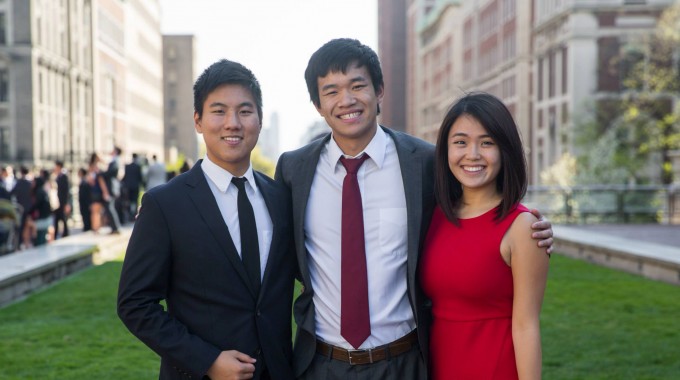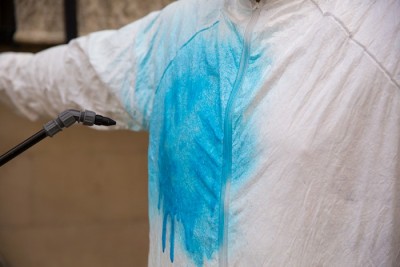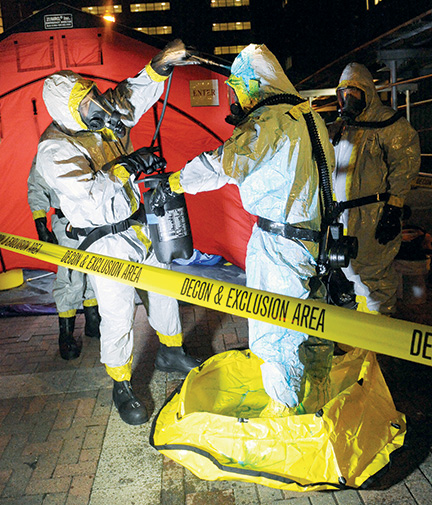If you know of a Columbia College student, faculty member, alumnus/alumna or program we should spotlight, or if you would like to submit a story, please contact:
Columbia College
Office of Communications
cc-comms@columbia.edu

“Ultimately, inventing Highlight and starting Kinnos with Jason and Katherine has been one of the most defining parts of my time at Columbia thus far.” — Kevin Tyan CC’16
In October 2014, Kevin Tyan CC’16, Katherine Jin CC’16 and Jason Kang SEAS’16 entered “Columbia Design Challenge: Confronting the Ebola Crisis,” a program sponsored by The Mailman School of Public Health and The Fu Foundation School of Engineering and Applied Science to conceive low-cost technology-driven solutions to meet the tremendous challenges posed by the Ebola crisis. They created Highlight, a powdered additive for bleach solutions that improves the effectiveness of bleach mist decontamination and ensures the safety of healthcare workers. After the Design Challenge, the trio formed a company, Kinnos, for their product. In April 2015, they were awarded third place in the Columbia Venture Competition’s Undergraduate Challenge, a title that came with an award of $10,000. They were also chosen as a winner of the U.S. Agency for International Development (USAID)’s competition, Fighting Ebola: A Grand Challenge for Development, one of 15 teams selected from more than 1,500 applicants. Here, Kevin reflects on his experience as a member of the three-person entrepreneurial team.
I've been friends with both Jason and Katherine ever since we met freshman year. We all share similar passions about science and healthcare: Katherine and I are both certified EMTs in New Jersey and New York, respectively, and have been first-responders for medical emergencies. Jason is the vice president of engineering at Jibon Health Technologies, a startup founded by recent Columbia graduates driven to solve global health problems through creative engineering, and has helped invent a device for postpartum hemorrhage in low-resource countries. So when Columbia launched the Columbia Design Challenge: Confronting the Ebola Crisis last October, it seemed natural for us to team up and try to tackle the challenges of the Ebola epidemic. And there's definitely no better feeling than to be able to contribute to fixing a crisis with your best friends as your partners.
The inspiration for Highlight came from a problem that became especially apparent during the Ebola crisis. Healthcare workers wear personal protective equipment suits to protect themselves from exposure, but rely on sprayed bleach to decontaminate their suits before removal. When we tested this method of decontamination for ourselves, we discovered how difficult it is to visualize where you've sprayed when using a transparent liquid like bleach. Additionally, we realized that spraying bleach on waterproof suits resulted in droplets that rolled off the surface, making the decontamination less effective. Once we saw how flawed the current method of bleach spraying was, we were inspired to look for a simple and inexpensive solution that could improve the decontamination method, offering healthcare workers a safer and more effective process without overcomplicating the necessary procedures. After all, healthcare workers on the front lines of a crisis like the Ebola epidemic may not have the time or resources to learn how to operate complicated devices or to use something that requires additional training or overhauls in preexisting protocol. And so we created Highlight.
 Highlight, a powder that you add directly into bleach before spraying, colors the bleach blue and helps it stick onto any surface. Here, Highlight is sprayed onto a PPE suit. Photo: Kyle Lee SEAS’17; courtesy Kevin Tyan CC’16
Highlight, a powder that you add directly into bleach before spraying, colors the bleach blue and helps it stick onto any surface. Here, Highlight is sprayed onto a PPE suit. Photo: Kyle Lee SEAS’17; courtesy Kevin Tyan CC’16
We received further inspiration and motivation from meeting with healthcare workers who had worked on the ground in West Africa. We spoke to a nurse with Doctors Without Borders who had returned to the United States after working in Sierra Leone. She told me that the visual aid that Highlight provides would be immensely helpful during the decontamination process, especially for healthcare workers with limited training. She also said that currently, the only reassurance healthcare workers have when spraying down their suits is the smell of chlorine. With Highlight, we are trying to provide these workers with the tools they need to protect themselves and with the confidence necessary for them to continue their lifesaving work.
Our collective experiences in healthcare and science at Columbia have been invaluable in driving this project. Jason’s work deploying medical devices in developing countries with Jibon Health Technologies provided him with a valuable perspective on how we could most benefit the healthcare workers in West Africa. My experience as an EMT for Columbia, along with Katherine’s volunteer work at Mt. Sinai St. Luke’s Hospital, helped us to empathize with the healthcare workers putting themselves at risk to treat sick patients.. Espeically after Dr. Craig Spencer fell ill with Ebola in New York City six months ago, we felt that there was a dire need to improve decontamination practices not just for West Africa, but on a universal scale. We thus formed a company, Kinnos, with the goal of providing preventive and life-saving measures to healthcare workers around the world.
 An ebola patient simulation and demonstration by the FDNY at Mt. Sinai Hospital. Photo: FDNY; courtesy Kevin Tyan CC’16
It has been incredibly encouraging to see how interested people are in Highlight. The Fire Department of New York (FDNY) reached out to us in November about possibly using Highlight for their HazMat teams. In that moment, we realized that Highlight was applicable not only for infectious diseases, but for decontamination and personnel safety in general. The FDNY has since purchased units of Highlight from us to equip on their firetrucks.
An ebola patient simulation and demonstration by the FDNY at Mt. Sinai Hospital. Photo: FDNY; courtesy Kevin Tyan CC’16
It has been incredibly encouraging to see how interested people are in Highlight. The Fire Department of New York (FDNY) reached out to us in November about possibly using Highlight for their HazMat teams. In that moment, we realized that Highlight was applicable not only for infectious diseases, but for decontamination and personnel safety in general. The FDNY has since purchased units of Highlight from us to equip on their firetrucks.
In April, we were chosen as a winner of the U.S. Agency for International Development (USAID)’s competition, Fighting Ebola: A Grand Challenge for Development. We are one of 15 teams that will receive a portion of the $5 million award . Our team also came in third place in the Columbia Venture Competition Undergraduate Challenge, a win that has ensured us the means to take the next steps in building our business. As a result, we will be working on Highlight this summer, as well as throughout the next academic year, to improve the scientific rigor behind Highlight as well as to perform field and compatibility testing. While the current formula for Highlight is suitable and has been validated by infectious disease experts and industry leaders, the funding we’ve received from USAID and from Columbia will help us to fully optimize our product and to ensure that it is ready for deployment to West Africa, a goal we hope to realize by January 2016. From collaborating with the NIH to test Highlight on live Ebola virus to ensuring that Highlight functions perfectly in many different conditions, thanks to support from USAID and Columbia, there is a lot that we will be able to accomplish.
I hope to one day see Highlight used for all future infectious disease outbreaks. I also have high hopes for our company and I am confident that we will continue to innovate. Ultimately, inventing Highlight and starting Kinnos with Jason and Katherine has been one of the most defining parts of my time at Columbia thus far. It has opened my eyes to what is really important about being at an institution like Columbia: the ability to surround yourself with your closest peers to try to make a difference in the world.
Kevin Tyan CC'16, from Bethesda, Md., is a biology major and a pre-med student. He is a co-founder of Kinnos, a startup that has developed Highlight to improve the decontamination of infectious diseases. He also serves on the executive board of Columbia University Emergency Medical Service.